About this blog: This travel blog on Bhaktapur will plan your travel to the temple town and cultural capital of Nepal. Should you stay at Bhaktapur for a night or visit as a day tripper from Kathmandu? What are the most beautiful temples of Bhaktapur? We have also listed a few accommodation choices in Bhaktapur at the end of the article.
Here is a complete series of travel blogs from Nepal!
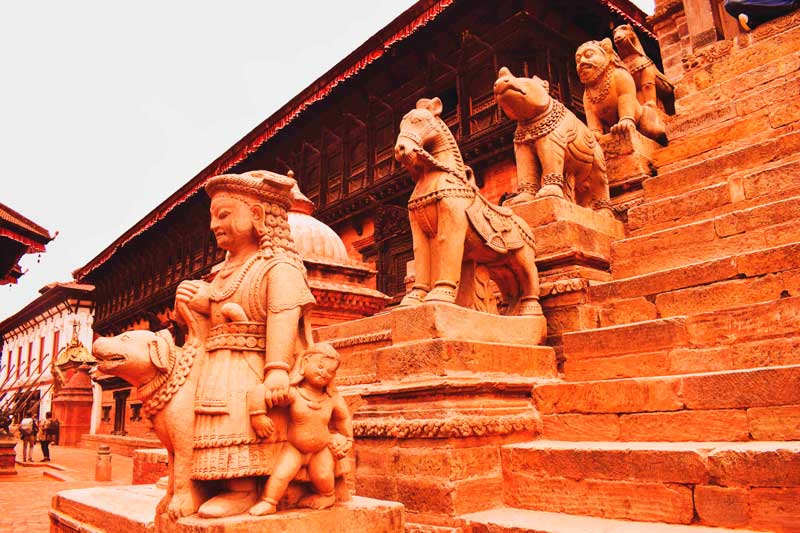
Bhaktapur, rebuilt from the rubbles of 2015 Gorkha earthquake!
Enter Bhaktapur: City of Art and Culture. Nepal’s best Kept Secret?
The parting sun’s goodbye kiss turns the red bricked edges of Bhaktapur’s old rooftops into crimson gold. Red, burnt red, so bright that it dazzles my eyes and crawls into soul celebrating the wisdom of this old heritage town of Nepal.
She is no ordinary city, she is Bhaktapur, the timeless capital of Culture in Nepal, where history lives and breathes at every alley, every window pane, the curve of an arch beyond the famed Bhaktapur Durbar Square! “A living Museum” as our guide Karunakar said.
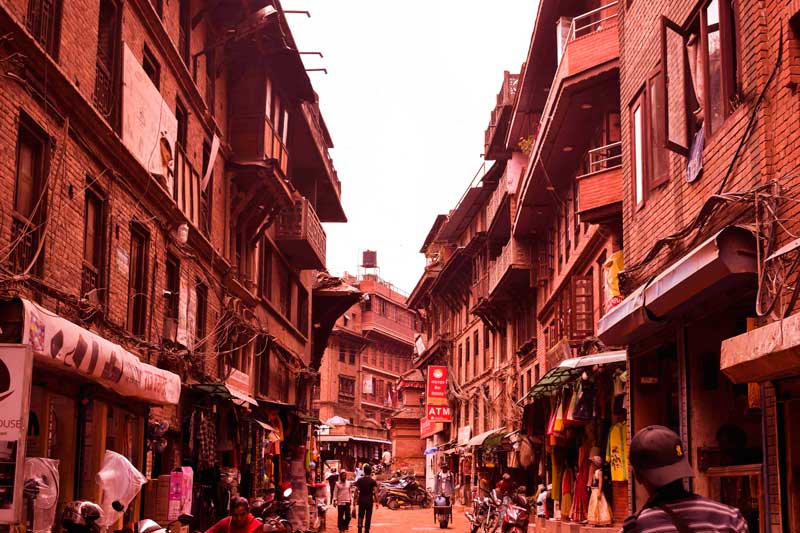
Look at the houses, all hues in uniform rustic red!
And she protects. She gently shoos away the maddening rush of 21st century from the threshold, only makes way for visitors on foot through the narrow winding serpentine lanes, beyond which lies the mighty Himalayan ranges.

I reached Bhaktapur Durbar Square at the beginning of the day. Life unfolded on the streets of Bhaktapur by the sheer virtue of faith. I watched a man, drawing a Tilak on the forehead of Radha Krishna Jugal idol, and putting it back to his own forehead and embracing the stone carving, historic in appearance.
Embracing, because that is how the deities are blended in Nepali Hindu culture.
Did you know: Bhaktapur in Nepal is also known as Bhadgaon (pronounced bud-gown, the City of Rice). The local Newari community call Bhaktapur “Khwopa”, loosely translating to City of Devotees.
Bhaktapur: a city of Bhaktas, devotees!
Bhakta, the word translates into devotee. The city Bhaktapur derives her name from devotion is full of devotees. A woman lights hundreds of Diya on a temple on the sidewalk. Thick layer of moss has grown in the rectangular water reservoirs, bordered with a snake, carved out of stone. A boy rests at the feet of Narasingha, a fierce looking deity with the face of a lion and body of a man. The Garbhagriha of the temples are dimly lit, scented with ghee and a tiny stone statue, decked up in golden measures. Life unfolds in a beautiful and contented way!
Living with Gods in Bhaktapur!
Also Read, A Guide to Chitwan National Park: Terai Jungle Safari in Nepal!
Bhaktapur: The UNESCO World Heritage Town
Bhaktapur has been accredited as a UNESCO world heritage site, one of the seven such UNESCO heritage monuments from Kathmandu valley! The reason for UNESCO status, “outstanding universal value in humanity” will appear as you make your way from the Durbar square (the palace complex) to the residential block of Bhaktapur, now a majorly Newari community settlement.

The Hindu religious anecdotes transcends into Buddhist Stupas, whitewashed and installed in the courtyards. The eternal eyes of Buddha, protector of the valley, is painted on top of them. A melange of varied religious practices, their seamless assimilation and eventual finding of harmonious living, manifests in the indegenous lifestyle of the local Newar community.
They become a part of the family, thus completing and complementing the sense of oneness.
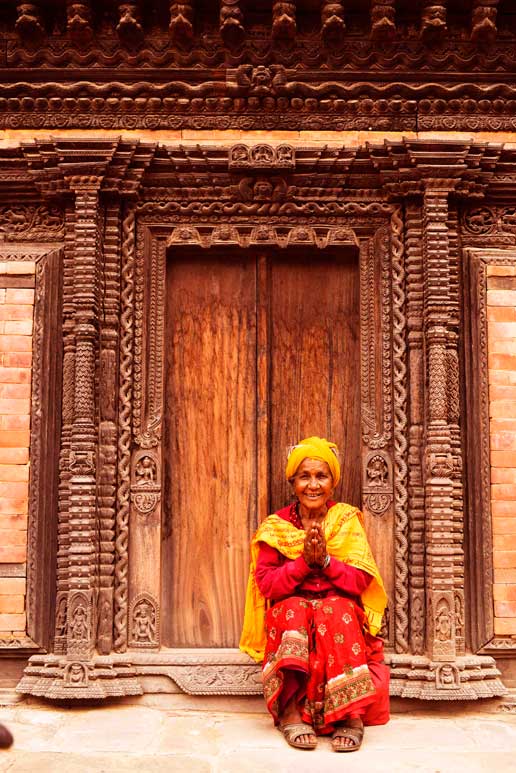
The city is dainty and reserves ancient mystics. A few minutes walk into the temple complex, and you know you have entered a time capsule. If you unearth the red cobblestone walkway, you will discover medieval relics, each bearing semblance with the kingdoms from the days of yore.
Bhaktapur is frail like your grandma, and thus invokes a copious amount of respect as spontaneous response.

History of Bhaktapur
Dating back in early 12th century, Bhaktapur was established by the Malla king Anand Dev. I wondered if they have any connect with the Mallabhum kings of Bishnupur, Bankura!
Nonetheless, Bhaktapur was the seat of power for the Malla reign till the last stretch of 15th century AD.

Once an important connector between Into-Tibet trade route, Bhaktapur found an important role in the economy of time bygone and drew direct benefits in splendor, remnants of which can be traced back in the elaborately designed palaces and temples.
Every other house is a temple in Bhaktapur, every other day is a festival. The essence of Malla kingdom is deeply rooted at Bhaktapur. World has underwent sea=change but time stood still at the lion’s gate of Bhaktapur!
The kings’ patronage has left behind incredibly rich architectural and cultural legacy made of wood, metal and stone.
Until the 15th century, Bhaktapur was a united kingdom. However, it was further divided among the three sons of the king, before finally being triumphed by the Sha dynasty of the Gorkha community, thus bringing an end to the sprawling art practices by Newar community. Nothing is apolitical in human history.

How to reach Bhaktapur Durbar Square from Kathmandu?
Bhaktapur stands at a distance of 12 KM east of Kathmandu. It is situated at an elevation of 1401 Meter from sea level.
Minibuses from Kathmandu starts plying from as early as 7 AM. You should get down at Kamal Binayak stop for entering Bhaktapur. Micro bus leaves frequently from Kathmandu to Bhaktapur. Availability of these mini vans can be based on variable factors.
From Thamel market or Baudha, you can hop on to a taxi as well for Bhaktapur. I recommend fixing on a price rather than going by meter.
A bus ticket is 30 NPR while a taxi shall cost you between 600 to 800 NPR.
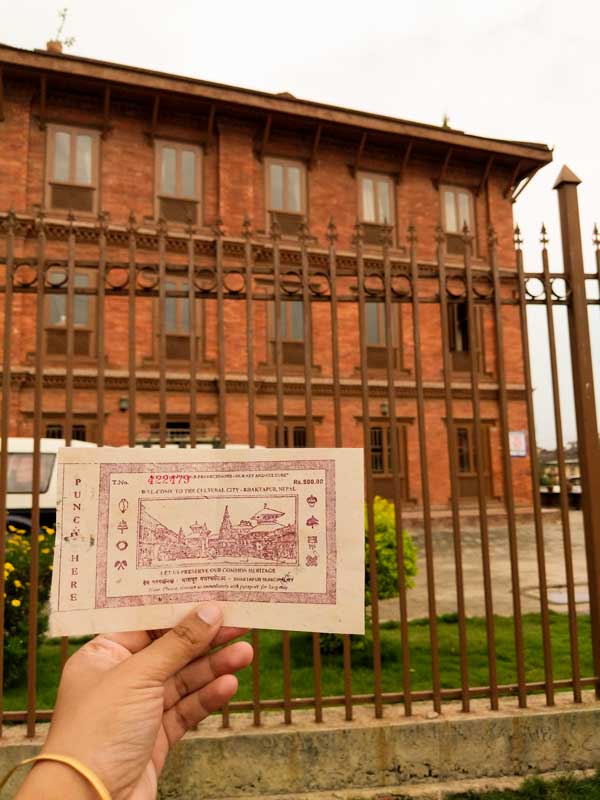
Tickets for Bhaktapur Durbar Square
Entry to Bhaktapur Durbar Square is basis on a ticket you are bound to purchase at the main gate. It is priced at NRP 1500 for foreigners (NPR 500 if you are from a SAARC country, thus Indians pay around INR 450).
Upon showing your passport, this entry ticket shall be extended upto 1 week without any extra cost (same hold for the Boudha Stupa in Kathmandu).
It is at the ticket counter where you shall find a local guide who will help you explore the ancient heritage town. Guide charge depends on NPR 200/300 (or more basis on the number of people in the group).
If your night accommodation is booked at Bhaktapur, you are not required to pay the ticket price.
50+ pictures from Nepal, a Photo-blog!
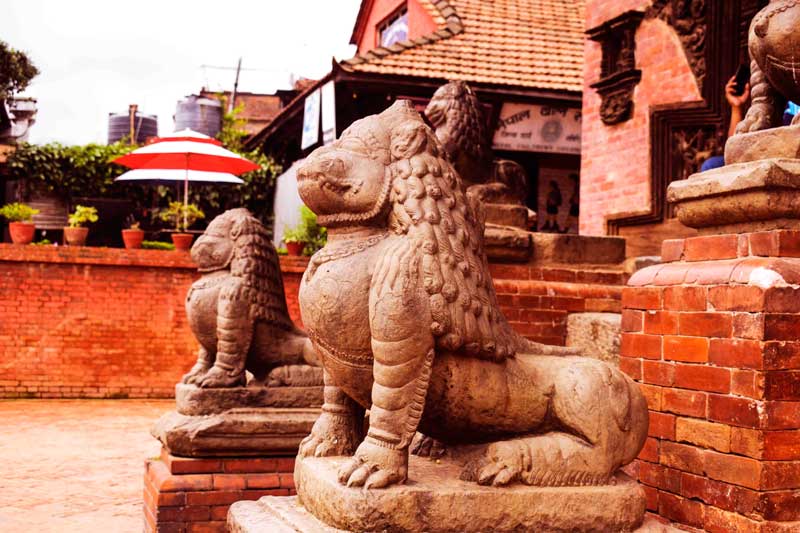
Things to do and places to visit at Bhaktapur Durbar Square
Armed with a paper map, I entered the city of Bhaktapur. For ease of discussion, I will break down my journey in 4 major squares that span the entire area of Bhaktapur.
Often hailed as an Open museum, Bhaktapur houses various shapes and sizes of temples, from the Newari pagoda to Shikhara and replica of Pashupatinath, intricately designed profound Lion gates, detailed window panes with bird and animal motifs.
Durbar Square is a local lingo that refers to a cluster of palatial buildings and important temples. Bhaktapur can be broadly classified into 4 squares, and they are:
Bhaktapur Durbar square
Taumadhi Square
Dattatreya Square
Pottery Square
You need to spend a substantial amount of time at each of them, exploring the temples and galleries. While commuting from one to another, you will glance upon life unfolding in unique measures at Bhaktapur households.
Bhaktapur Durbar square
The entry opens to the Basantpur Chowk, a sprawling courtyard by the royal palace, now partly converted into a museum.
On your left, stands the exquisitely detailed 55 window palace, built by the king Bhutapaditya Malla. The upper floor of the building is dotted with ornate wooden windows in line, “bringing in news from the world outside”!

On certain occasions, the Kumari (the controversial living goddess of Nepal) will make an appearance for public from one of the shutters. Entry to the window palace is closed for the visitors.
The windows of Bhaktapur indeed drew attention from the royal palace. The Western wing of it has been converted into the National Art Gallery, showcasing relics and antiques.

Two massive lions guard the entrance.
Close to the palace, stands the entry to Taleju Goddess temple.
Lu Dhowka or Golden Gate
The Golden Gate stand somber at the edge of the royal palace. She, like the doors of the universe, protects the secrets of the interiors of the Malla king’s royal palace, protects them from the dust and hustle of the world outside.

Ever seen how the world looks inside a king’s home? The Golden gate allows you to enter and explore.
But before you do, take a lingering look at the golden gate itself. A work of art and reverence.
The four headed Goddess Tulaja Bhabani stands with her guards up. Gaduda, the birdman of Hindu mythology is fighting an odd battle with massive serpents, all his wings stretched in attention and caution. The drama creates a lasting impact on my mind.

Doors can speak volume. They keep the secret of the family from the world outside. They stand silent witness to myriad events, and protects. So did the golden gate.
Taleju Bhabani Temple Complex
Legends has it, the patron Goddess of Newar community, Taleju Bhabani would appear in Malla king’s dream, even play chess with him while suggesting on “Rajkarja”, the impending course of actions for his court!

The temple complex of Taleju Bhabani now houses a few statues of Gods. One of them, a Goddess with close to 20 hands and the face of a boar attracted my attention. “Barahi” is the name, suggested the guide.
The Taleju Bhabani temple complex restricts entry for non-Hindus. Photography is not allowed either.
Inside the main temple complex, a courtyard stands with murals of the Goddess and empty narrow hallways opening in a pond and an animal sacrificing alter. Buffalo and goats are sacrificed at this temple.
I could spot fresh blood and droppings. A stone lion stands in attention.
A few men were preparingg to cook the meat. I ask if they add onion and garlic.
In Bengal, we worship female Goddess and sacrificing an animal (strictly a goat) is a common practice. We do not add onion and garlic in the meat and call it “Niramish- vegeterian- Mangsho”.
Perhaps, I was trying to join the dots and trying to connect Taleju Bhabani with Kali Kolkattawali but reality differed. “Sab dalte hain”, answered me the cook, “We mix in everything!”
Take a little detour and you shall reach the Naga Pokhri, the royal bathing enclosure, bordered with a King Cobra. A Shiva linga stands near the steps.

The Nag Pokhri and its Golden faucet, nuances of a royal bath place!
“A Shivalinga always points towards the north. That is how people in the older times would find their way!”, the guide quipped.
Opposite to the temple complex of Taleju Bhabani, stands Chyasin Mandap, the octagonal monument shaped after pagoda.

Standing tall by its side, the Big bell or the barking bell (as Dogs start to bark as the bell rings, justified since it is HUGE), is an old timer.
The Pashupatinath temple of Bhaktapur
Pashupatinath, literally translates to the lord of animals. Myriad species of animals, some as close as the Nandi bull (Shib’s ox), some straight from the art book of a highly imaginative human: all share space on this replica of Kathmandu’s supremely revered Shiva temple.
Watch out for the wooden struts that support the roof of the temple. Various erotic sculpture depicting the cycle of life and creation and destruction are on display.

Innumerable number of temples adorns the streets of Bhaktapur Durbar Square. Siddh Laxmi, Vatsala devi (that is a Durga temple), Shiva Temple (Fasi-dega), Bhandarkhal Complex, Chatu Brahma Mahavihar, Indrayani Temple, Balakhu Ganesh Temple. The list goes on…
On the other side of Chowk, stands the Char Dham on Nepal. Char Dham Jatra is one of the epic pilgrimage of Hindus in India, for which you will cover an expance of the country’s north to south and east to west. Whereas, in Bhaktapur, Nepal, the Char Dam temples are situated across the Chowk. They are Kedarnath, Dwarkanath, Badrinath and Jagnathpuri temple.
Taumadhi Square
The oldest of all squares in Bhaktapur, Taumadhi Tole harbors a fascinating story of power play between Parvati and Bhairaba, another form of Shib, two stalwarts of Hinduism. .
As a result, you shall witness the colossal Nyataponla Temple, standing tall amidst a group of residential Newari buildings of rustic red hue, despite the massive earthquakes that rocked the area decades apart!

Legends has it, the Goddess Paravati appeared in front of the king Bhupatendra Malla and bestowed him with shelter from Bhairav’s Tandab (a series of destruction, believed to be caused by Shib’s dance).
The Nyatapola temple, a towering Shikhara at 30 meter from the ground, and the tallest of the country commemorate the event.
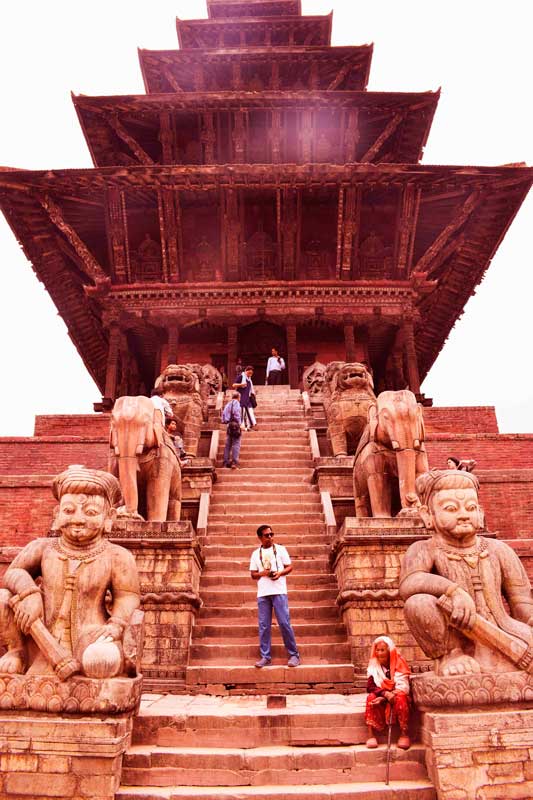
The temple houses Siddhi Lakhshmi, a Tantric deity. While visitors are allowed to climbe atop the five story temple, the door to “Garbhagriho” is closed except for the priests. On the day of Dasain festival, you get to see the Goddess.
Did you know: the Nyataponla Temple is a contemporary of the Taj Mahal. Its completion date however was prior to that of Taj Mahal.
The stairway to the temple is dotted with historic characters. In the first step, you meet the two iconic Rajput wrestlers, Jayamel and Phattu.
The following steps have a couple of elephants, lions, and griffins. The top of the stairway is under the guardianship of the Tantric goddesses Byaghrini and Singhini.

From the top, you can see the rather small in comparison to the rectangular shaped Bhairavnath Temple. A pillar stands erect with the bust of king Bhupatindra Malla in between.
From a distance, the mountain ranges of Himalaya paints the horizon. .
Other notable temples of the Taumadhi Square are: Betal temple, Til Narayan Madhaba temple.
Dattatreya Square
Dattatryara is the other name for Bramha, the rarely seen deity of Hindu trinity: Bramha, Bishnu, Maheswar!
I could not recall another temple dedicated to Bramha except for Pushkar until I saw the famed Dattatreya temple!
A three story intricately curved wooden temple, Dattatreya temple in Bhaktapur marks the end of “antique road”. Believed to be formed of the trunk of one single tree, Dattatreya temple stands for three centuries defying a series of natural calamities that floored the peers of Dattatreya square.

At the footsteps of the Dattatrya temple, you will be greeted the by Rajput wrestlers Jayamel and Phattu once again!
An important festical for the deity is Mohani festival (Dasain festival).
Dattatrya Square houses the second Taleju shrine of Bhaktapur, at the Wane Layaku complex. On the occasion of Dasain festival (we celebrate Durgapuja in Kolkata at the same time), the very fair water clock from Malla era, the Ghau-batacha is put out for public viewing. the clock coupled with astrological insights by the nobles of the court would chalk out time and date for important actions by Malla court.
Peacock Window: the Mona Lisa of Nepal
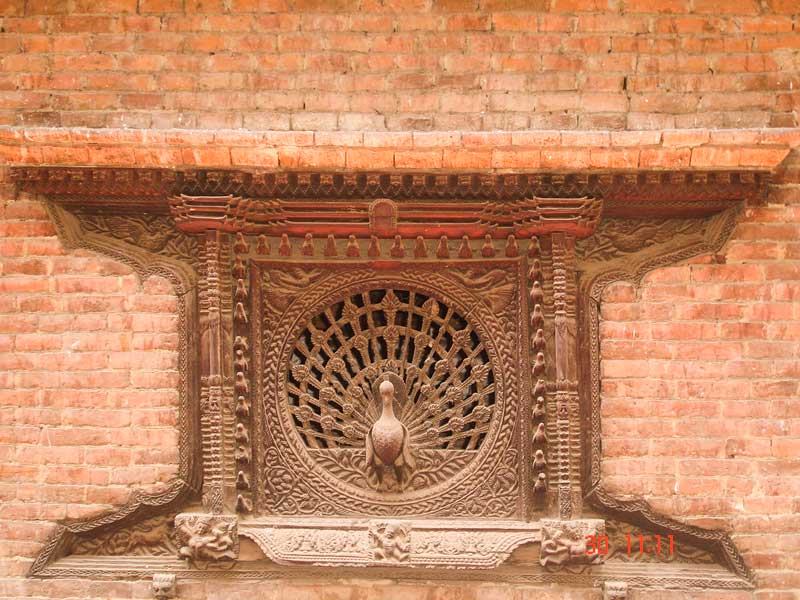
Almost 500 years old, the peacock window is an epitome of window art by the Newar community which appears at the end of a narrow lane, very typical to Bhaktapur’ residential area. the window seats pretty on the wall of Pujari Math coupled with few more intricately detailed wooden work.
The building also houses antic artecrafts of wood curvings. It is actually the woodcurving museum.
Other notable temple of datatrya Square: Tripura-Sundari Temple
Pottery Square
The grandeour of old days remain in Bhaktapur in form of pottery. the local artisans create beautiful terracotta products which are used in abundance at the local house holds as well as sold as souveniers. Think the beautiful masks inspired by the smile of Buddha!

The intriguing part of Bhaktapur’s pottery is the much coveted black clay. Once in every years, a certain amount of black clay is dug out of the ground and shaped into different wares. potters follow traditional wheel to form the clay.

The 2015 earthquake in Nepal and it’s impact on Bhaktapur
Bhaktapur Durbar Square is shaped after a conch shell. The durbar square, where multiple palace structures and the main temples are, is walled.
The 2015 Earthquake wrecked the center of Bhaktapur. The entire city with her ancient structures were reduced to rubble. A handful of old massive temples defied the shock and stood tall.
You might be familiar with pictures of men walking past debris in teary eyes as the Maitreyi Buddha sits calmly in the background. This, in turn, may put your decision to travel to Bhaktapur into question.

Well, time has progressed and Nepal has rebuilt herself. Bhaktapur, being a UNESCO heritage site, received funding from around the globe, Germany being one of the major sources for crowdfunding. Today, you can see most of the temples being rebuilt with care and precision. Bhaktapur is being rebuilt from the rubble.
Bhaktapur, good for a day trip or shall I spend a few nights here?
If you are pressed for time, a quick day trip to Bhaktapur from Kathmandu will open the world of old times for you. However, I strongly recommend spending at least one night at Bhaktapur. The city has plenty to offer for those with a taste of culture. the chowk area comes alive after sunset, with cafes and shops. Bhaktapur also has beautiful hotels to stay in.
A night stay at Bhaktapur is often complimented by an early morning visit to Nagarkot the next day. From the view point at nagarkot, you can view the high ranges of Himalaya and Mount Everest on a good sunny day.
Personally, I found the capital city Kathmandu is plagued by dust and traffic. I loved Bhaktapur, which, on the contrary, seemed to master the art of tranquility.

Where to stay in Bhaktapur?
Check out a list of mid ranged hotels in Bhaktapur here suitable for one night’s stay.
In particular, I loved these boutique properties:
Tulaja Boutique hotel looks over the Nyatapola temple with a beautiful background of the Himalaya.
Thagu Chhen, a Boutique Hotel, almost set up as an apartment with beautiful view and traditional decor.
For budget yet comfortable option, check out the following hotels in Bhaktapur. All of them are located within walking distance from the Bhaktapur durbar square.
Kumari Guest House (beautiful traditional styled rooms)
What to eat at Bhaktapur Durbar Square
While the more prevalent elements of Newari cuisine, Daal Bhat thali is available at almost every restaurant and cafe, my mind goes back to the iconic Juju Dhau of Bhaktapur.
A creamy yogurt topped with a crunchy layer, befitting the royal past of Bhaktapur, Juju Dhau is made of buffalo milk and can only be found at Bhaktapur. It is served set on earthen pots, locally known as “Katura”.
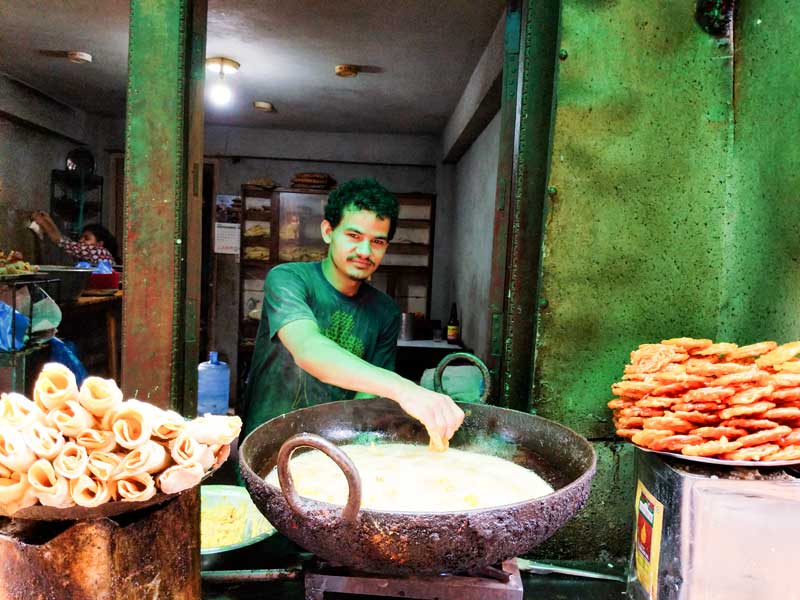
Sel roi, Samosa, roasted soybeans, dried rice flakes and curried potatoes are served as snacks. You can also snack on some buff momo sold at NPR 30/50 at various street side shops.

Buy a souvenir from Bhaktapur
The glory of regal past makes its presence felt at every artisan’s quarter at Bhaktapur. A few women sat by the window, busy painting masks with precision. The old winding streets are dotted with old walls, hanging hand painted masks and peacock mirrors. Wooden dolls shaped after Hindu mythological characters drops from a rope. A look at them and you can not move until you have got one for back home! Huge Thangka painting and Mandala mats are available at these shops, a perfect pick for those having a taste for meditation.

Best time to visit Bhaktapur
Bhaktapur can be accessed all year round, however the drizzles of monsoon months can be a challenge to explore the city by foot. Hence, monsoon, in my opinion is best avoided.
Temperature in Bhaktapur remains similar to that of kathmandu. It can become hot and humid in summer and bitter chilly in the winter months, though usually it doesn’t snow at Bhaktapur.

Photography tips for Bhaktapur
People in Bhaktapur are jolly and usually more than happy to pose for the camera. It is always a respectful way to ask for permission beforehand though.
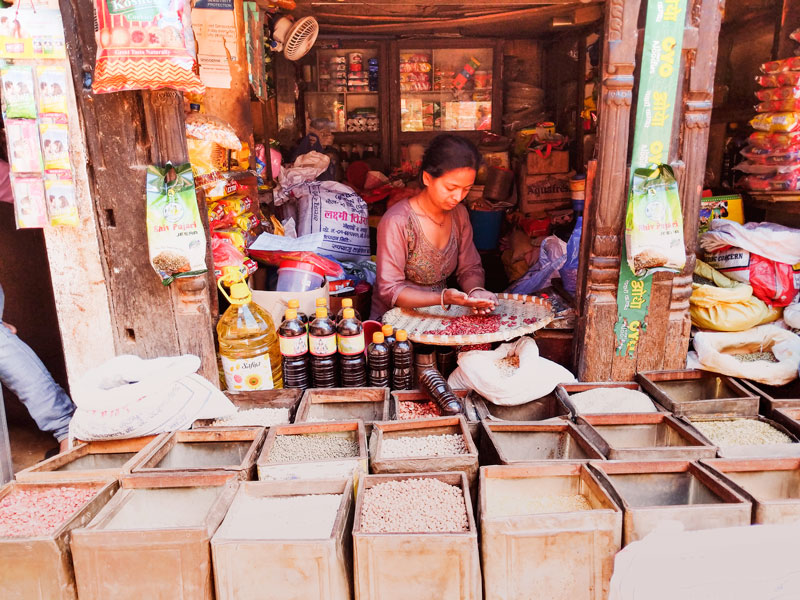
Early morning sun rays play a beautiful hide and seek romance with the old city. Head out with your camera during sunrise to capture the best picture, before the day tripper crowd arrives in bus from the city!
Things to know before you go
Life at Bhaktapur unfolds with religious practice, some of them may bring cultural shock for westerners. Say for example, a goat sacrifice.
However, as I had mentioned before, the deities are a part of the local households, very much a part of family. The sacrificed goat shall be consumed by the locals, and shall be offered to the Goddess beforehand.
Me being a Bengali, this practice seemed to be very common. The staircase of Kalighat in Kolkata sometimes turn red with goat blood. Remember Rabindranath’s famed dialogue from Raktakarabi , “Why is there so much blood?”
Few of the temples only allow Hindus to enter. Photography is not allowed. I suggest being culturally sensitive in situations like that.
To preserve the sanctity and curb congestion, rickshaws, tuk-tuks or taxis are not allowed to be used by the tourists. Locals can ride though.
It takes around half an hour to cover the expanse of the city, without stopping at “points”.
Carry a map to ensure you are not lost in the dusty winding roads inside Bhaktapur.
While there is no specific rule to wear a certain type of dress, it is always wise to dress modestly to avoid unwanted attention from the locals. The area is dotted with living temples and you are likely to come across few rituals, in which case, that modest aka covered piece of clothing is always a savior.

Day trips from Bhaktapur
Sated with the countless number of ancient temples of Bhaktapur you may consider going out and exploring a few important sites close by.
- Hanumanghat
At the edge of the old Bhaktapur, Hanumanghat stand with many Shib-Lingas and a cremation Ghat.
2. Thimi
You might have seen the Nepalese masks on the lanes of Bhaktapur, however if you fancy experiencing the make of them, head towards Thimi. Apart from being the vegetable growing garden for the whole of Kathmandu valley, Thimi has historically excelled in the pottery endeavors of Nepal.
3. Nagarkot
From Bhaktapur, Nagarkot is roughly 20 KM drive. What tiger hill is to Darjeeling, Nagarkot is that to Kathmandu. On a good sunny day, you can see the rays of sun romancing the peaks of high Himalaya, including that of the Mount Everest!
4. Changu Narayan
The oldest pagoda temple built by the Lichhavi kingdom of Kathmandu valley, Changu Narayan temple is located at a distance of 4 KM from Bhaktapur.
5. Dhulikhel town
The ancient town strategically located between Indo-Tibet trade route is an excellent choice to stop for a night in case you are geading towards Namobuddha. Similar to Nagarkot, you can rise before sunrise and reach the view point to see the high himalayn ranges. A clear sunny day is all you need to befriend!
Let’s stay connected on Facebook, Instagram, Twitter! You may also consider joining my mailing list. I send travel and photography related emails only once a month!
Pin it for later!
This post may contain affiliate links. Please read the disclosure post. If you have liked the article, you may support it by buying using these links without any extra cost to you.

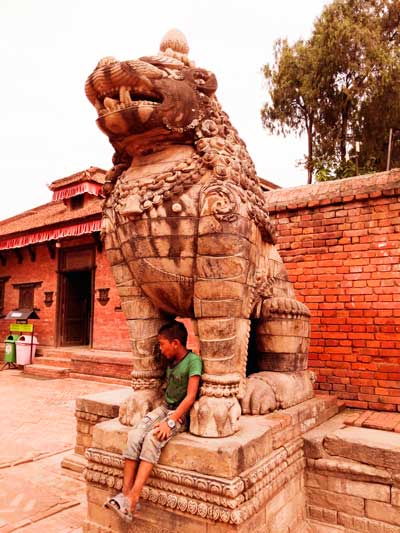


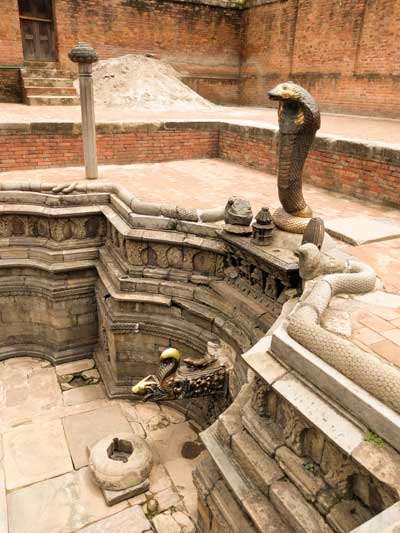


Wow, I was wondering how places might have been affected after the earthquake, thank you for touching on that. Nepal sounds like such a rich experience
Actually, the Earthquake rocked Nepal and rocked it quite bad! Nonetheless, the country is recovering with everyone’s help.
Well written, very well detailed and beautiful photos!
Thank you!
I would love to go to Nepal. It looks so welcoming. Thanks for the great post!
You should! Now is the time to visit Nepal!
Loved the read. Want to visit Nepal so much.
Glad it inspired you!
We are AC closed meat mart with hygienic meat from our own slaughtering house. Our meat preserves in cold, clean and closed environment and handling also very neat and clean. Contact us for all hygienic meat product of chicken, mutton, and other. Himalayan Meat Mart Bhaktapur. We deliver for you on your doorstep with free of cost. For more detail visit our site http://himalayanmeat.blogspot.com
Wow, Bhaktapur is such a beautiful place. Great article about Bhaktapur and its Culture.
Thanks for share this Nepal famous tourist destination bhaktapur Check out our nepal tour package
Your vivid descriptions transported me to the enchanting streets of Bhaktapur, evoking a palpable sense of its rich history and cultural allure. Your passion for travel shines through every word, inspiring wanderlust and a deep appreciation for the wonders of Nepal.
Thank you for sharing this beautiful post on Bhaktapur! The vivid descriptions and historical context truly bring this heritage city to life. Practical tips on transport, tickets, and accommodations are super helpful, while the focus on Bhaktapur’s unique culture and architecture gives readers an authentic feel of the place. Well done!
Thank you for sharing this wonderful post!
Bhaktapur, a UNESCO Heritage town of Nepal, is a living testament to the country’s rich history and culture. Its ancient temples, vibrant festivals, and traditional architecture make it a must-visit destination for history buffs and culture enthusiasts. The town’s unique blend of tradition and heritage is truly breathtaking.